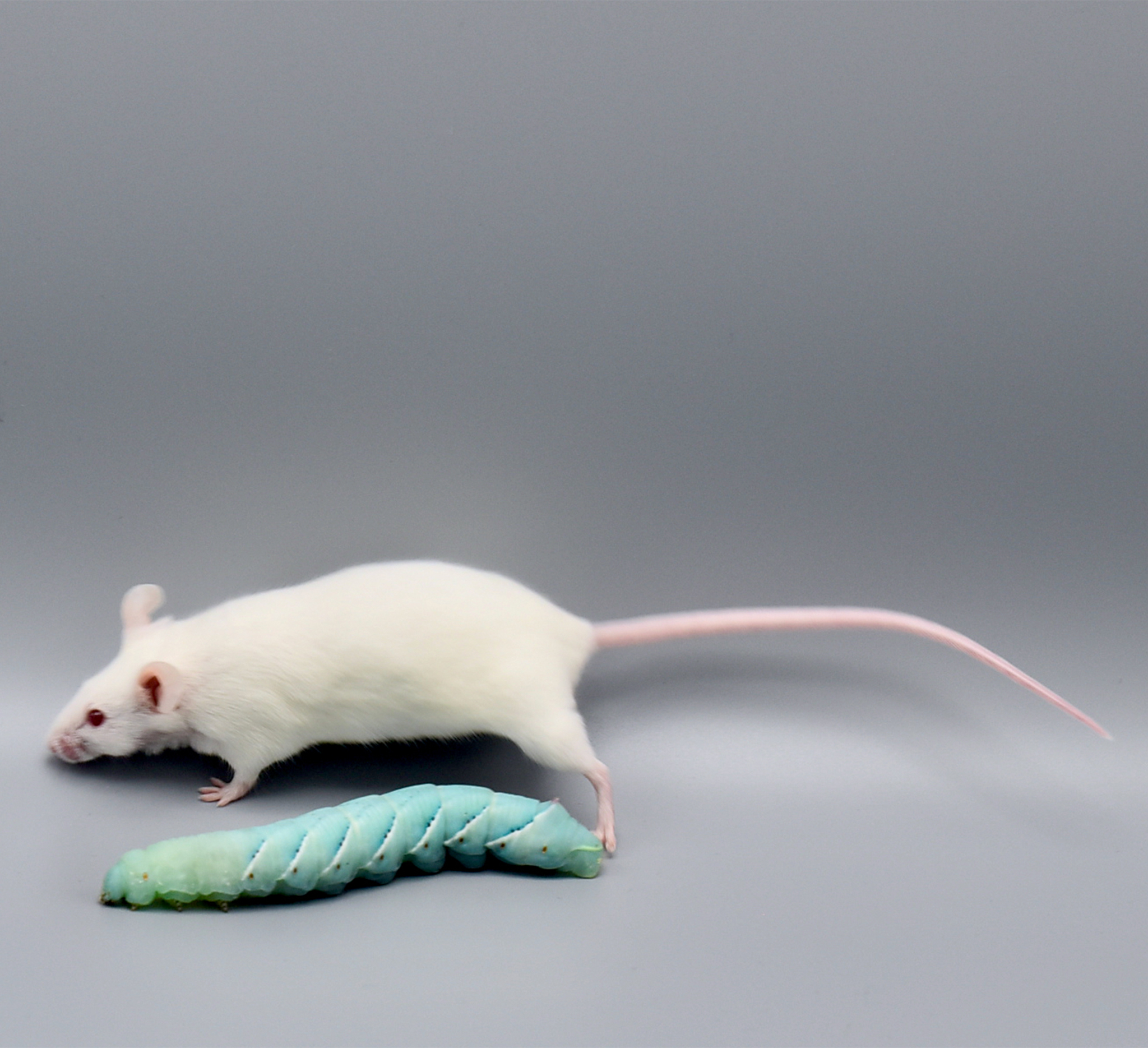Caterpillars as a replacement for mammalian models in preclinical research
Inflammation research is becoming more ethical and economical: caterpillars help to understand gut inflammation and enable the faster and more efficient development of new therapies.

Insects, like caterpillars, suffer from the same or related diseases as humans because 75 % of genes associated with human illness are also present in insects. Consequently, caterpillars like the tobacco hornworm can be used as a model organism, improving the understanding of diseases and helping to test and develop new therapies or diagnostic tools. A team around Anton G. Windfelder, a zoologist at the University of Giessen and employee of Fraunhofer IME, Germany, are reporting the alternative use of caterpillars to study chronic inflammatory bowel diseases in Nature Communications.
"Inflammatory diseases of the alimentary tract affect millions of people worldwide, and the incidence of chronic inflammatory bowel diseases is rising globally," says Dr. Windfelder. "The innate gut immunity and the organization of the intestinal epithelium of tobacco hornworm larvae are comparable to those of mammals. However, in contrast to other insects such as Drosophila, the fruit fly, caterpillars of tobacco hornworm are large enough for medical imaging." Together with national and international cooperation partners from Düsseldorf, Germany, and New York, USA, Anton G. Windfelder and team developed an innovative and unique imaging platform. "We use medical imaging modalities like computed tomography (CT), magnetic resonance imaging (MRI), and positron emission tomography (PET) to characterize a gut inflammation in tobacco hornworm." says Gabriele Krombach, Head of the Clinic for Diagnostic and Interventional Radiology at UKGM Giessen, who is a co-author of the study.
"Intestinal inflammation in larvae of tobacco hornworm is diagnosed using contrast media and tracers such as FDG (18F-desoxyglucose)," says Dr. Windfelder. "This is in analogy to the diagnosis of gut inflammation in humans." Anti-inflammatory medications such as cortisone, used in acute flares of human chronic inflammatory bowel disease, also show a significant reduction in gut inflammation in the larvae of the tobacco hornworm. The advantage of the imaging platform is that multiple animals can be studied simultaneously. Up to 100 animals can be examined in a few seconds using CT. In contrast to traditional methods, the animals stay alive and survive. "The animals tolerate the anesthesia and imaging very well and can continue to live after the experiments."
With the publication mentioned, Windfelder and team want to draw attention to the successful alternative use of insects in early preclinical research. "Of course, insects like cannot fully replace mice and rats.” adds Andreas Vilcinskas, head of the Fraunhofer IME in Giessen and head of the Institute for Insect Biotechnology at the JLU Giessen, who was also involved in the study. "Evidence from cell culture is often not reproducible in in-vivo systems like mice," Vilcinskas says. "Here, insects like Manduca can help identify promising new targets or therapies worth further investigating in traditional mouse models." This would speed up research and make it more affordable. In this way, researchers could significantly reduce the use of classic laboratory animals and thus contribute substantially to animal welfare.

Publication
Anton G. Windfelder, Frank H. H. Müller, Benedict Mc Larney, Michael Hentschel, Anna Christina Böhringer, Christoph-Rüdiger von Bredow, Florian H. Leinberger, Marian Kampschulte, Lorenz Maier, Yvette M. von Bredow, Vera Flocke, Hans Merzendorfer, Gabriele A. Krombach, Andreas Vilcinskas, Jan Grimm, Tina E. Trenczek & Ulrich Flögel: High-throughput Screening of Caterpillars as a Platform to Study Host-microbe Interactions and Enteric Immunity. Nature Communications 2022
DOI: 10.1038/s41467-022-34865-7
Further info
www.ime.fraunhofer.de/en/model_organisms | www.insekten-biotechnologie.de | https://www.ukgm.de/ugm_2/deu/ugi_rad/index.html
Founded in 1607, Justus Liebig University Giessen (JLU) is a research university with a long-standing tradition which attracts almost 26,500 students. Apart from the wide range of subjects on offer ‒ extending from classical natural sciences, law and economics, social and educational sciences to linguistics and cultural studies it offers a selection of life science subjects that is unique not only in Hesse: human and veterinary medicine, agricultural, environmental and nutritional sciences and food chemistry. The leading personae who carried out research and taught at JLU include a number of Nobel Prize winners, such as Wilhelm Conrad Röntgen (Nobel Prize for Physics in 1901) and Wangari Maathai (Nobel Peace Prize in 2004). Since 2006 JLU has been receiving continuous funding from German central and state governments in the Excellence Initiative and the Excellence Strategy.
The Fraunhofer-Gesellschaft based in Germany is the world’s leading applied research organization. Prioritizing key future-relevant technologies and commercializing its findings in business and industry, it plays a major role in the innovation process. A trailblazer and trendsetter in innovative developments and research excellence, it is helping shape our society and our future. Founded in 1949, the Fraunhofer-Gesellschaft currently operates 76 institutes and research units throughout Germany. Over 30,000 employees, predominantly scientists and engineers, work with an annual research budget of €2.9 billion. Fraunhofer generates €2.5 billion of this from contract research.
 Fraunhofer Institute for Molecular Biology and Applied Ecology IME
Fraunhofer Institute for Molecular Biology and Applied Ecology IME